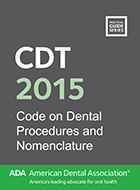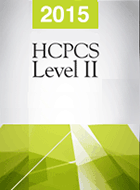The following Coding & Classification resources have been newly updated for 2015 and STAT!Ref has them available now. These resources ensure that your practices are prepared for Dental Procedure Code changes, Current Procedural Terminology code changes and the new Healthcare Common Procedure Coding System codes for 2015.
Code on Dental Procedures and Nomenclature 2015 gives dental staff a resource to code and document services accurately for claim submissions and dental records. Relying on old information may lead to unexpected claim denials or reimbursement delays. CDT 2015 is the most up-to-date coding resource, and the only HIPAA-recognized code set for dentistry. Improved organization and handy tables allow users to find information more quickly, and make correct coding easier for everyone.
CDT 2015 Contains:
- Revised implant section with 8 new codes, 4 deleted codes and 10+ revised codes
- New codes for post-operative visits, sealant repair, evaluation for deep sedation or general anesthesia, and missed appointments
- Simplified table format for single and multi-surface restorations
- Reorganized maxillofacial section for quicker reference
- Claim form with detailed instructions for completion
Code changes include:
- 16 new procedure codes
- 52 revised procedure codes
- 5 deleted procedure codes
CPT® Data Files, OPTUM™ is based on the America Medical Association's Physicians' Current Procedural Terminology (CPT)® coding system, which is copyrighted and owned by the physician organization. CPT® is the nation's official, HIPAA, compliant code set for procedures and services provided by physicians, ambulatory surgical centers, and hospital outpatient services, as well as laboratories, imaging centers, physical therapy clinics, urgent care centers and others.
This best-selling annual title serves as a reference tool to understanding each of the CPT® code changes found in the CPT® 2015 code book. Organized in the same manner as the CPT code book, this guide provides the official AMA rationales for every new, revised and deleted CPT code and guideline.
Whats New:
- New Codes (242)
- Changed Codes (121)
- Deleted Codes (147)
HCPCS Level II is the Healthcare Common Procedure Coding System, established by CMS's Alpha-Numeric Editorial Panel. HCPCS primarily represents items, supplies, non-physician services not covered by the AMA's CPT-4 codes. Medicare, Medicaid and private insurers use HCPCS procedures and modifier codes for claims processing.
The HCPCS level II coding system is a comprehensive and standardized system that classifies similar products that are medical in nature into categories for the purpose of efficient claims processing. For each alphanumeric HCPCS code, there is a descriptive terminology that identifies a category of like items. These codes are used primarily for billing purposes. For example, suppliers use HCPCS level II codes to identify items on claim forms that are being billed to a private or public health insurer.
In summary, the HCPCS level II coding system has the following characteristics:
- This system ensures uniform reporting on claims forms of items or services that are medical in nature. Such a standardized coding system is needed by public and private insurance programs to ensure the uniform reporting of services on claims forms by suppliers and for meaningful data collection.
- The descriptors of the codes identify a category of like items or services rather than specific products or brand/trade names.
- The coding system is not a methodology for making coverage or payment determinations. Each payer makes determinations on coverage and payment outside this coding process.
Also coming soon and effective Oct. 1, the ninth edition of the International Classification of Diseases (ICD) code sets will be replaced by ICD-10. Did you know that STAT!Ref has made the process for the ICD transition much easier, with integrated cross-reference conversion tools? These panels on the STAT!Ref subscription home page are free to those customers that have purchased both ICD-10-CM and ICD-10-PCS.
Simple and straightforward new panels on the STAT!Ref interface allow users to enter in a ICD-9-CM or ICD-9-PCS code and get a pop-up panel containing the ICD-10-CM or ICD-10-PCS equivalent. Or, simply get the reverse translation functionality at the click of a button. Again, these extremely valuable panels are available free to those that purchase both ICD-10-CM and ICD-10-PCS.
Click here for an informative handout about the STAT!Ref coding resources and tools. Or, please contact a STAT!Ref Team Member here or by calling 800-901-5494 to speak about these new editions and features or to schedule a webinar demonstration when it best suits your schedule.


